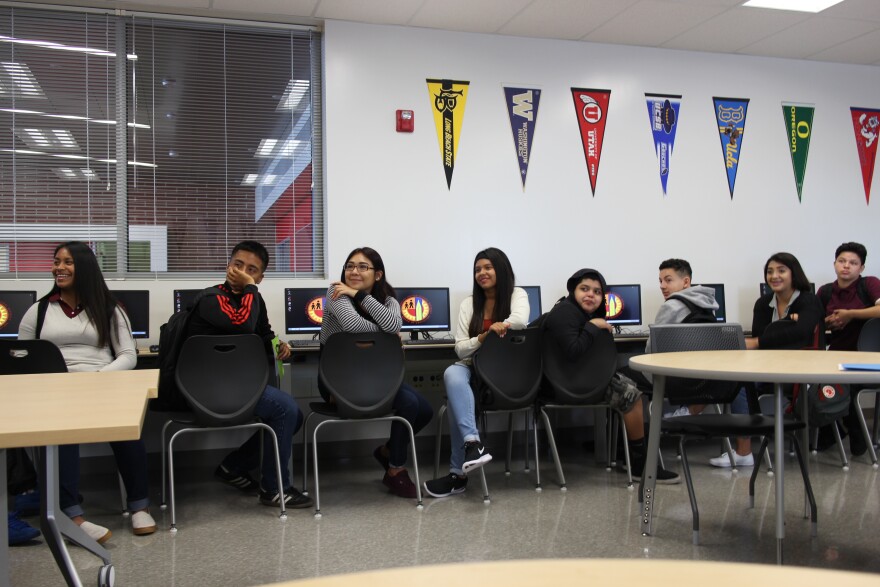Truth matters. Community matters. Your support makes both possible. LAist is one of the few places where news remains independent and free from political and corporate influence. Stand up for truth and for LAist. Make your year-end tax-deductible gift now.
This archival content was originally written for and published on KPCC.org. Keep in mind that links and images may no longer work — and references may be outdated.
California's 2nd attempt to meet federal education law looks much the same

When California submitted its plan to comply with a new federal education law late last year, the U.S. Department of Education officials didn't seem too impressed.
California's plan to follow the Every Student Succeeds Act, or "ESSA" — the latest iteration of a longstanding federal mandate that states must identify and help the worst-performing schools — was essentially incomplete, the feds said. That response only fueled the fears of advocates and civil rights groups, already worried California's ESSA plan would shortchange vulnerable kids.
On Thursday, State Board of Education members voted to send a new draft of California's ESSA plan back to the U.S. Department of Education — but with barely any changes to the substance in the earlier version.
The subtext of state officials' message to both the feds and critics appeared to be "trust us."
With the state's first draft, state board president Michael Kirst said, "I don’t think [federal officials] were able to grasp what we were really doing." He expressed confidence that the revisions would "clarify the issues raised" by federal officials during their first back-and-forth.
Under the new federal law, each state is required to submit a plan for tracking students' performance not only on standardized tests, but in other areas: high school graduation rates, English language proficiency measures and other factors. The law's explicit goal — baked right into its name, "Every Student Succeeds" — is to close the gaps in achievement between privileged and vulnerable groups of students.
ESSA also requires state officials figure out how to measure schools that perform in the bottom five percent of all schools statewide. In California, that percentage translates to at least 300 schools that state officials must identify as the worst-performing.
As it happens, the state last year unveiled a system with a similar aim to the federal law. The California School Dashboard uses a range of data points — from student test scores to suspension rates — to create what officials say is a comprehensive picture of a school's performance.
State officials prefer using the Dashboard as a means of identifying schools in the most need of improvement. They fear coming up with separate metrics to fulfill the feds' requirement would cause confusion — which is what happened under the federal statute that immediately preceded ESSA, the No Child Left Behind law.
"When we finally let it go," said state board member Ting L. Sun during Thursday's meeting, "and just said, ‘let’s trust our system, let’s just trust what we’ve designed might actually work well and identified schools that need to be identified,’ this is what we got."
But in a Dec. 21 letter, U.S. Department of Education officials said California officials haven't fleshed out many of the details for how the Dashboard would be used. The feds' letter notes the state's accountability system is not a hand-in-glove fit with ESSA: the state's system identifies the districts in the need of most help, but the federal government requires identifying the schools in need of the most help.
"We're worried that if you only look at districts, you're going to overlook some pretty poor schools," said Brian Rivas of the organization Education Trust-West in public comments Thursday. "We don’t want districts to be able to hide a bad school in the system."
But some advocacy groups said the new draft plan state board members voted to submit did not fully resolve these methodological questions.
One prominent education advocacy and lobbying group, EdVoice, also seized on the U.S. Department of Education's comment that as the state sets big, overall goals for seven years in the future, the state's ESSA plan includes no "interim" targets it hoped to hit each year.
"The plan instead creates over 1,000 different targets by allowing districts to determine, on their own, measurements necessary to meet the statewide long-term goal," EdVoice's executive director, Bill Lucia, wrote in a letter to the board. "This relies on tepid goals that will never put all schools on track."
Lucia was blunt in his criticism. In that letter, dated Jan. 12, he called the revisions the board submitted "meaningless." In a written statement sent after the board's vote Thursday, Lucia said the new draft "appears to put California in clear violation of the federal law."
Other voices were more supportive.
In written comments, the California School Boards Association urged U.S. Department of Education officials to "allow the continued evolution of the state’s accountability and continuous improvement system, which focuses attention at the district level where funds flow and decisions are made."







